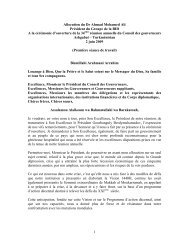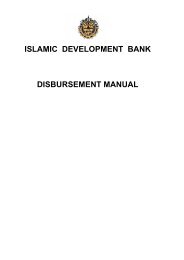Mauritania - Islamic Development Bank
Mauritania - Islamic Development Bank
Mauritania - Islamic Development Bank
Create successful ePaper yourself
Turn your PDF publications into a flip-book with our unique Google optimized e-Paper software.
% in 2009). The short-lived oil boom in 2006-<br />
2007, which accounts for only a small share of<br />
the natural resource rents accumulated during<br />
several decades, seems to have had little effect<br />
on the REER.<br />
28. Evidence of “pronounced Dutch Disease<br />
effects” during the three decades from 1970<br />
-2000 has also been noted in independent<br />
analysis 6 focusing on governance issues arising<br />
from windfall gains. This assessment is based on<br />
evidence indicating: (a) stagnation in the share of<br />
agriculture (including livestock) with its 2004 share<br />
in GDP of 16 percent “barely half that expected for<br />
a country at <strong>Mauritania</strong>’s level of development”<br />
and noteworthy for a country with “150,000<br />
irrigable hectares which, with improved livestock<br />
management and roads to access markets, could<br />
lift agriculture’s share of GDP above the expected<br />
one-third level”, (b) manufacturing is “two-thirds<br />
the size expected”, and (c) the remarkably low<br />
commercial farm output has cut the agricultural<br />
sectors capacity “to stimulate agro-processing”.<br />
The root cause of this economic stagnation is<br />
attributed to a “rent driven economy” which in the<br />
three decades received sustained high rents from<br />
iron ore extraction, fishing and aid amounting to<br />
“one-third of GDP” and with political allocation of<br />
the rents, encouraged by lack of transparency and<br />
poor governance.<br />
29. It is vital that the Government develops a<br />
strategy to manage economic rents from natural<br />
resources extraction to mitigate the adverse<br />
economic effects of long-term exchange rate<br />
appreciation and strengthen the links between<br />
the two economies. It can do this by among other<br />
things: (i) Moving towards more value-added<br />
production in all areas where it has a comparative<br />
advantage in terms of resources—fisheries,<br />
livestock, mineral ores, and oil. (ii) Addressing<br />
other constraints to enhancing linkages between<br />
the two dual economies for example human<br />
development and capacity building; and (iii)<br />
Facilitating investment in activities such as<br />
construction, that is less vulnerable to exchange<br />
rate appreciation.<br />
6 See “Aid and Rent-Driven Growth: <strong>Mauritania</strong>, Kenya and Mozambique<br />
compared, Richard M. Auty, 2007.<br />
10<br />
III. MAURITANIA’S VISION, DEVELOPMENT<br />
CHALLENGES AND PRIORITIES<br />
1. Poverty Reduction Strategy Paper 2001-2015<br />
30. The PRSP (2001-15) sets out the vision<br />
of <strong>Mauritania</strong> as a politically stable and<br />
democratic country, which transforms itself<br />
into a decentralized and modern state, well<br />
integrated with the regional and global economy<br />
on the path of sustainable economic and social<br />
development. The Government is implementing<br />
this vision through multi-year action plans the<br />
latest of which, PRSP III covering the period 2011-<br />
2015, is in the final phase of preparation following<br />
consultation with civil society, private sector and<br />
development partners. PRSP III has been designed<br />
taking account of the lessons learnt from the<br />
implementation of PRSP II and I (see Box 1).<br />
31. For PRSP III, the <strong>Mauritania</strong>n government<br />
intends to maintain the objectives set in the two<br />
previous PRSPs. PRSP III outlines development<br />
priorities and interventions in a five-year action<br />
plan, clustered around four strategic objectives<br />
outlined below with increased emphasis on<br />
private sector development, monitoring and<br />
evaluation and donor coordination as a crosssector<br />
theme.<br />
i. Acceleration of Growth and Stabilization of<br />
Economy: The Plan will meet this objective<br />
through interventions designed to stabilize<br />
macroeconomic balances, improve the<br />
business environment for private sector<br />
development, support sectors with a potential<br />
for high growth, and reform the state<br />
owned enterprise sector to facilitate fiscal<br />
consolidation.<br />
ii. Anchoring Growth in the Economic Sphere<br />
of the Poor: The Plan aims to achieve this<br />
objective through interventions that support<br />
rural development, target pockets of urban<br />
poor, promote microfinance and SMEs,<br />
enhance food security, reduce environment<br />
degradation and reorient policies to focus<br />
on targeted poverty reduction programs.<br />
Expected outcomes of these interventions are<br />
an increase in the contribution of rural sector<br />
MCPS for <strong>Mauritania</strong>, 2011-2015






